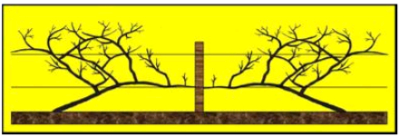
Bouche-Thomas hedges
 The last forest garden tidbit
that caught my fancy was Robert Hart's Bouche-Thomas hedges. He
planted apple trees diagonally so that they grew into each other and
created a rigid
fence like the one shown in the drawing here. Since I'm currently
in the research stage of including
hedges on our property, these looked intriguing.
The last forest garden tidbit
that caught my fancy was Robert Hart's Bouche-Thomas hedges. He
planted apple trees diagonally so that they grew into each other and
created a rigid
fence like the one shown in the drawing here. Since I'm currently
in the research stage of including
hedges on our property, these looked intriguing.
Overall, I found Robert
Hart's Forest Gardening
to be a bit disappointing since it was low on how to information and on
plants suitable
for North American climates. His book isn't a reference work so
much as it is a dreamer's manifesto. But it often
takes a dreamer to bring an idea like forest gardening to a temperate
climate. The next generation of forest gardeners are still
working to make his dream a reality.
| This post is part of our Robert Hart's Forest Gardening lunchtime
series.
Read all of the entries: |
Want more in-depth information? Browse through our books.
Or explore more posts by date or by subject.
About us: Anna Hess and Mark Hamilton spent over a decade living self-sufficiently in the mountains of Virginia before moving north to start over from scratch in the foothills of Ohio. They've experimented with permaculture, no-till gardening, trailersteading, home-based microbusinesses and much more, writing about their adventures in both blogs and books.
Want to be notified when new comments are posted on this page? Click on the RSS button after you add a comment to subscribe to the comment feed, or simply check the box beside "email replies to me" while writing your comment.

I don't know if these hedges would be much good in a real hedge situation --- apple trees are just too tasty to keep any animals back! I think your idea is good, or using some kinds of thorny plants like wild roses or the osage-oranges we're going to try. I suspect the Bouche-Thomas hedges are more of a method of saving space and adding in more species in a small area, something Robert Hart was obsessed with.
I suspect you'd have to keep training/pruning the trees every year, like an espalier. A lot of work if all you want is a living fence! But not so bad if you've just got a bit of space in a city setting and want to line your fence with apple trees.
I have had 5 cherry trees and six apple trees planted as B-T hedges in my back yard in Tasmania since 1983. The system is effective at maximising output from minimum area but requires constant attention to pruning to prevent the hedge becoming a thicket of vertical stems.
The system depends on reducing the dominance of the apical bud (the top bud on the leader stem or laterals, thereby inducing heavier and earlier fruiting, which in turn reduces vegetative growth. It works reasonably well, but in my experience needs a winter prune and a summer trim. Miss either and pretty soon the natural desire of the trees to grow UP will take over and all the laterals will grow vertically.
This is just one version of a range of cultural systems intended to increase fruit production at the expense of branch growth. It would not work to contain stock or exclude wildlife: the structure must be kept open for light to penetrate to the far side of the hedge to ripen the fruit
Thanks for this post and the comments which are valuable. I really love your site and what you are doing.
I am going to try this at our urban local.
Keep up the great work.